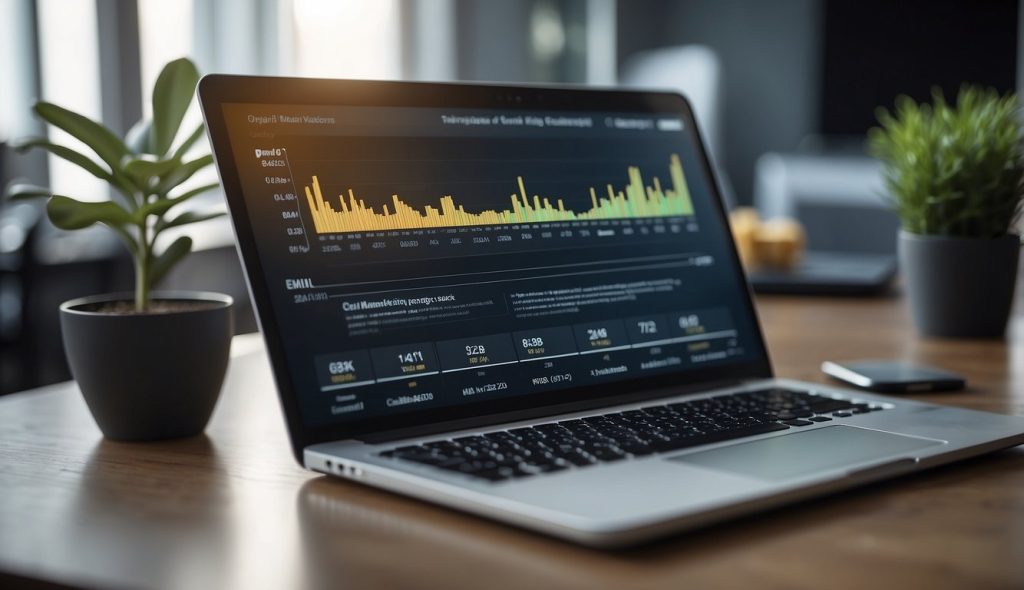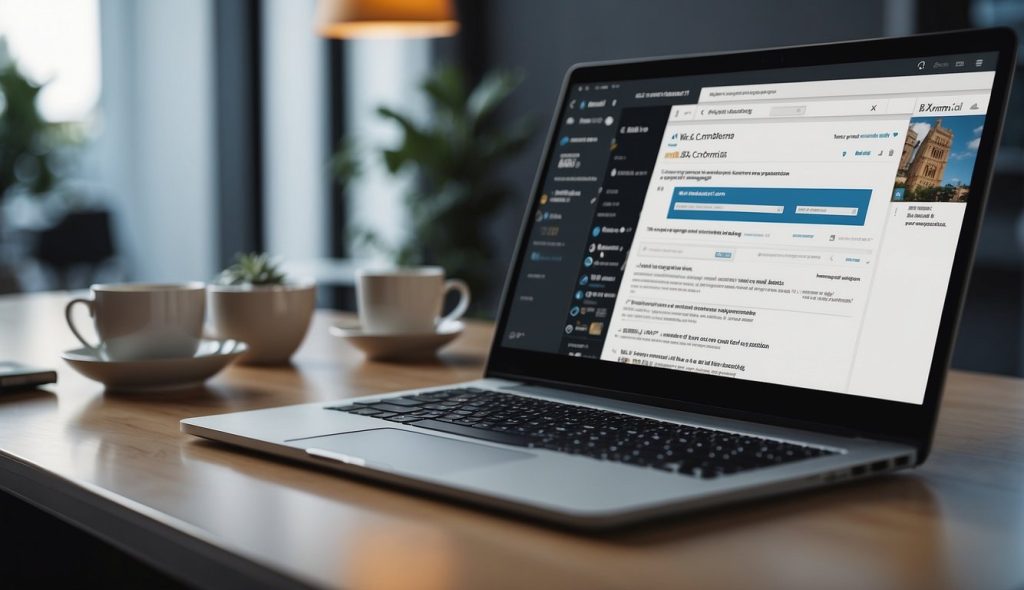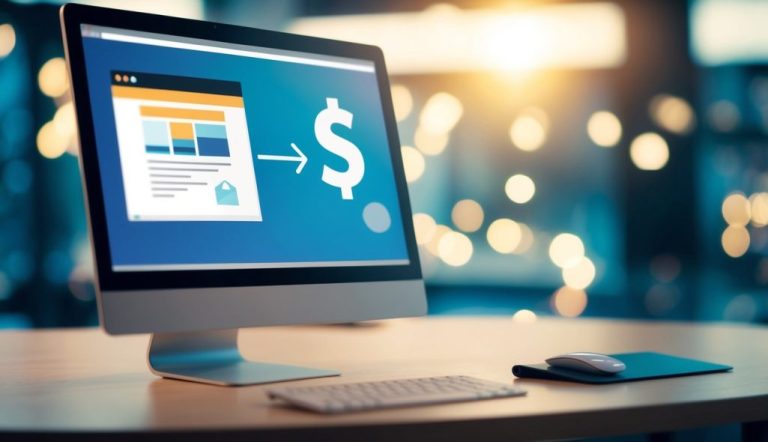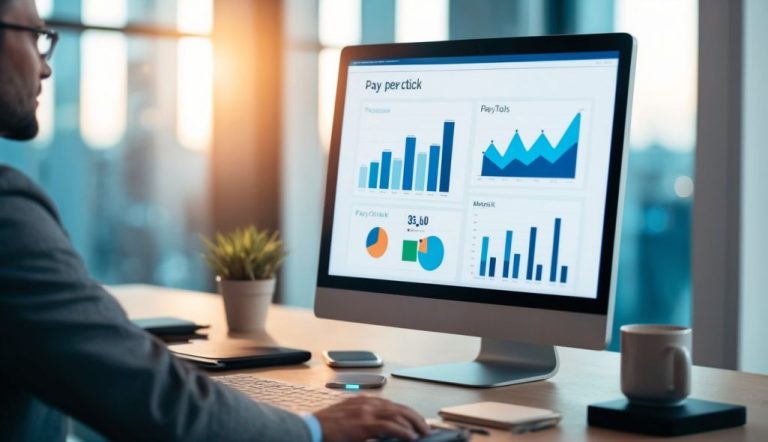B2B email marketing is a powerful way to connect directly with your business audience, promoting your products or services in their inboxes. It’s essential to a broader digital marketing strategy, enabling a direct and personalized path to communicate and build relationships with other businesses. You can drive engagement, nurture leads, and convert prospects into loyal customers by delivering valuable content tailored to different organizations.

Developing a well-thought-out B2B email marketing campaign involves understanding your target audience, crafting compelling messages, and thoughtfully designing each email to align with your company’s objectives. It’s not just about sending out emails; it’s about sending the right message to the right people at the right time. With robust strategies and tools, you can manage your email lists, segment your audience for targeted campaigns, and analyze the results to optimize future communications.
Key Takeaways
- B2B email marketing is an impactful strategy for personalized business engagement.
- Successful campaigns require precise targeting, compelling content, and strategic timing.
- Analyzing campaign effectiveness is crucial for optimizing future email marketing efforts.
Understanding B2B Email Marketing
Before diving into the world of B2B email marketing, you need to grasp its defining characteristics and significance in your overall marketing strategy. This will equip you with a firm foundation to effectively communicate with other businesses and drive growth.
Defining B2B Marketing
B2B marketing is the practice of promoting products or services to other businesses rather than individual consumers. Unlike B2C marketing, your strategies here must cater to the needs, interests, and challenges of organizations making rational, rather than emotional, purchasing decisions. In this realm, you target decision-makers who think about bottom-line revenue, efficiency, and long-term partnerships.
Importance of Email in B2B Strategies
Email remains a pivotal marketing channel for B2B marketers. It’s a direct line of communication to your business prospects and clientele. Through B2B email marketing, you can foster a relationship that could culminate in a loyal brand advocate or a long-term business partnership. When used correctly, it’s a tool that can lead to significant digital marketing success, contributing substantially to overall business growth.
Consider emails your digital handshake—a way to introduce and position your brand in the crowded marketplace by providing value and nurturing trust over time. This personalized approach often sets successful businesses apart in their B2B strategies.
Developing Your B2B Email Marketing Strategy
Crafting a B2B email marketing strategy requires a nuanced approach tailored to the professional context of your target audience. This section delineates the steps and considerations to optimize your email campaigns for maximum engagement and conversion.
Defining Your Target Audience
You need to identify who you’re speaking to to kick off your strategy. This begins with creating your buyer personas. A buyer persona is a detailed description of your ideal customer, including their job title, industry, pain points, and what kind of solutions they might be hunting for. Your CRM data, customer feedback, and market research inform this profile.
Consider the following attributes when defining your target audience:
- Industry: Which sectors are most likely to benefit from your offering?
- Company size: Are you targeting small businesses or large enterprises?
- Role: Who in the organization is your point of contact?
- Pain points & challenges: What problems can your product or service solve for them?
Align your email content with the marketing funnel stages, from awareness to consideration and, finally, decision, ensuring you address your audience’s specific needs and interests at each step.
Email Marketing Best Practices
- Segment Your List: Break your email list into segments based on industry, company size, or engagement level to increase relevance and impact.
- Personalize Your Messages: Utilize your information about your prospects to personalize your emails, making each message feel tailored and considerate.Examples of personalization:
- Using the recipient’s name
- Referring to their specific business needs
- Providing solutions relevant to their stage in the sales funnel
- Subject Lines Matter: Your subject line is your first impression. It should be compelling and clear and convey the value of opening the email.
- Content is King: Your email content should provide value, whether it’s through insightful content marketing, practical advice, or exclusive offers.
- Call to Action: Every email should have a clear call to action (CTA) that guides recipients toward the next step, be it learning more about a product, signing up for a webinar, or scheduling a demo.
- Test and Optimize: Continuously test various aspects of your emails, from subject lines to CTAs to send times, and use the data to refine your approach.
Integrate your email marketing efforts with other channels for a cohesive experience, ensuring your messaging is consistent across all platforms. By employing these best practices, you position your B2B email marketing to nurture prospects effectively through the buyer’s journey, ultimately leading to a stronger relationship and increased sales.
Building and Managing Your B2B Email List
Your email list is the heart of your B2B email marketing efforts. Building a robust list of leads and managing it effectively is vital to nurturing potential customers and driving your business forward.
Acquiring Leads
Acquiring leads is the first step to grow your email list. Start by offering value through free resources or tools on your website, prompting visitors to subscribe. Ensure your sign-up forms include custom fields so that you gather essential information about your leads from the get-go. This data will be crucial for personalized communication and segmenting later on.
- Utilize content offers like whitepapers, ebooks, or exclusive webinars.
- Attend industry events and conferences to connect with potential customers physically.
- Optimize your website for conversions with straightforward and visible sign-up forms.
- Consider using referral programs that incentivize current subscribers to refer qualified leads.
Segmentation and Personalization
Once you’ve begun to accumulate contacts, it’s crucial to segment your email list to cater to different groups’ specific needs and interests. Use the information you’ve collected from your custom fields and tags to classify your leads.
Effective segmentation might include:
- Industry type
- Company size
- Role in the purchasing process
- Past engagement with your emails
Empower your communications with personalization. Go beyond just inserting a name in an email. Tailor your messaging based on the segment’s characteristics and behavior to nurture your leads more effectively.
- Include relevant case studies or industry insights that resonate with each segment.
- Craft emails considering the particular pain points and interests of each group.
By acquiring high-quality leads and enhancing your email list management with segmentation and personalization, you’re set to nurture those leads into long-lasting B2B relationships.
Crafting Effective B2B Emails

To excel in B2B email marketing, your emails must capture attention and convey your message succinctly. This involves crafting potent subject lines and engaging email content that resonates with your audience.
Powerful Subject Lines
Your inbox competition is fierce, so your subject line is crucial to stand out. Consider your subject line a handshake; it’s the first impression and invitation to engage further. Strive for clarity and relevance to prompt opens. Here are some best practices:
- Keep it Short: Aim for subject lines under 60 characters to ensure they appear on most devices.
- Personalize: Whenever possible, use personalized content that includes the recipient’s name, company, or other relevant information to create a connection.
- Avoid Spam Triggers: Steer clear of overused sales phrases that could send your newsletter straight to the spam folder.
Creative Email Content
Once your email subject line has done its job, your content must maintain the reader’s interest. This is where your copywriting skills come into play. Structure your content for easy reading:
- Begin With a Strong Hook: Start your email with a statement or question that piques your curiosity and relates directly to your audience’s interests or pain points.
- Branding: Ensure your branding is consistent throughout the email to reinforce brand recognition.
- Conciseness and Clarity: Keep your email length optimal; brief enough to respect the reader’s time, yet long enough to provide value.
- Use Bulleted Lists: For readability and to highlight key points.
- Remember CTA: End with a clear call-to-action that guides your reader to the next step.
You aim to create emails your recipients will look forward to receiving, so always consider what’s in it as you write.
Enhancing Engagement and Conversions
In B2B email marketing, your ultimate goal is to build a strong relationship with your prospects. This means connecting with them emotionally, rising to maintain their interest, and boosting your conversion rates. Let’s dive into tactics to improve your engagement with potential clients significantly.
Welcome Emails and Nurturing
Welcome emails are your first impression, and they count for a lot in the business world. These emails set the tone of your relationship with new prospects and can kickstart the nurturing process. Here’s how to make them count:
- Personalization: Start with a friendly hello tailored to their needs or industry.
- Value Proposition: Quickly showcase the benefit of staying connected with your brand.
Nurture campaigns, often with drip emails, keep the conversation going. These are not just one-off messages but an orchestrated set of correspondences that guide your prospects through the customer journey.
- Education and Resources: Offer helpful content and resources to solve their problems and position yourself as the go-to expert.
- Consistent Contact: Maintain regular but not overwhelming contact to stay top of mind without being intrusive.
Advanced Email Campaign Techniques
Moving beyond the basics, let’s focus on techniques that can refine your email campaigns and enhance conversions:
- Segmentation: Dividing your email list based on industry, company size, or engagement level allows you to send more targeted content. This has been proven to increase engagement and could be the key to higher conversion rates.
- A/B Testing: Regularly test different elements of your emails (like subject lines, email copy, or call to action) to find what resonates with your audience and leads to better results.
Using these techniques thoughtfully ensures that your B2B email marketing efforts foster meaningful engagement and drive conversions. Remember, it’s about creating an experience that feels tailor-made for your prospects, making each communication an opportunity to strengthen the bond and move the relationship forward.
Analyzing and Optimizing Email Campaigns
To get the most out of your B2B email marketing efforts, you must meticulously scrutinize your campaign’s performance and optimize based on the findings. This involves focusing on critical metrics and conducting rigorous A/B tests.
Key Performance Metrics
Your email campaign’s success hinges on several key performance metrics. Essential ones to monitor closely are:
- Open Rates: Indicates how often your emails are being opened and directly reflects your subject line’s effectiveness.
- Click-through Rates (CTR): The number of people who click on a link in your email, showing how engaging your content and call to action are.
- Conversion Rates: The percentage of email recipients who take a desired action, proving the overall effectiveness of the email content.
- Unsubscribe Rates: Tracks the number of people who opt out of your email list, which can help assess audience contentment and relevance.
- Email Deliverability: Measures how often your emails successfully land in recipient inboxes, not spam folders.
- ROI: Return on Investment quantifies the profitability of your email campaigns.
To evaluate these effectively, leverage email analytics tools that provide in-depth insights into how your audience interacts with your emails.
A/B Testing for Improvement
Implementing A/B testing is akin to conducting a science experiment where you change one variable to test performance variations:
- Subject Lines: Test different subject lines to see which results in higher open rates.
- Content: Alternate between different email copies or images to determine which drives more engagement.
- Call-to-Action (CTA): Try varying your CTAs to determine which yields higher click-through and conversion rates.
A/B testing is continuous and should be carried out regularly since audience preferences and behaviors can evolve. It’s a proactive approach to refine your email strategies and enhance your campaign performance. Remember, incremental improvements can lead to significant impacts on your overall email marketing success.
Leveraging Technology in Email Marketing
Embracing technology in your B2B email marketing efforts can significantly enhance your ability to reach and engage your audience effectively. Selecting a capable email service provider and utilizing automation set up a foundation for success.
Choosing the Right Email Service Provider
When looking for an email service provider (ESP), choosing one that aligns with your business needs is crucial. An ESP like MailChimp provides a suite of email marketing services that can cater to various levels of campaign complexity. Here are vital factors you should consider:
- Deliverability: Ensure your emails reach the inbox, not the spam folder.
- Analytics: Look for in-depth reporting tools to track performance.
- Scalability: Your ESP should grow with your business needs.
Choosing a provider with a strong reputation and robust services will underpin the success of your campaigns.
Email Automation and Integration
Setting up email automation is like having an ever-vigilant assistant who ensures timely and relevant communication with your audience.
- Welcome Series: Greet new subscribers automatically when they join your list.
- Lead Nurturing: Deploy sequences that move prospects along the sales funnel.
Furthermore, integrating your email marketing service with other tools like CRMs or e-commerce platforms enables sophisticated targeting and personalization options, making each email feel custom-crafted for the recipient.
Ensuring Compliance and Deliverability
In the fast-paced world of B2B email marketing, your success hinges on two crucial factors: staying compliant with legal requirements and ensuring your emails reach your audience. Let’s dive into the specifics to make sure your campaigns run smoothly.
Adhering to Regulations
Your first step is to embrace permission-based marketing. This means obtaining explicit consent before sending out emails. Align your practices with regulations like the General Data Protection Regulation (GDPR) to protect your subscribers’ privacy and rights. Ensure each email includes an easy opt-out option and keep records of consent to maintain transparency.
- Consent collection: Keep consent forms clear and easily accessible.
- Record-keeping: Maintain up-to-date records of who has consented to receive your emails.
Maximizing Email Reach
To enhance email deliverability, regularly clean your email list and segment it to target customers effectively throughout their customer journey. Monitor metrics like bounce rates and spam complaints to keep your sender’s reputation intact. Stay informed about updates from email service providers, such as the February 2024 sender guideline updates, to ensure ongoing compliance and deliverability.
- List management: Regularly remove unengaged subscribers to reduce bounce rates and improve deliverability.
- Segmentation: Tailor email content based on where subscribers are in the customer journey.
Examples, Case Studies, and Resources
In B2B email marketing, real-life examples and case studies provide invaluable insights for crafting successful campaigns. Handpicked educational resources can empower you to apply these learnings throughout your sales cycle.
Real-world B2B Campaign Examples
- HubSpot’s Lead Generation: Discover how HubSpot transformed into a $271 million inbound lead generation machine, turning customer management into an art form.
- Asana’s Event Emails: Learn how Asana’s virtual workshop invitation exemplifies the use of event emails to attract and convert new customers effectively.
By examining these case studies, you’ll understand the strategic elements that successful businesses incorporate, from crafting compelling subject lines to segmenting the audience for personalized content delivery.
Educational Resources
For elevating your B2B marketing campaigns, here’s a selection of resources:
- Strategy Guides: Dive into proven B2B email strategies and examples that can guide you in structuring campaigns tailored for a business audience.
- Case Study Compilation: Benefit from 16 B2B marketing case studies, which provide insights directly from industry specialists, CEOs, and marketing managers.
These resources will provide you with actionable B2B email marketing tips and the educational content necessary to create valuable content that resonates with your audience and nurtures them through the sales cycle.
Building Long-Term Relationships
In B2B email marketing, your ability to nurture lasting relationships with your clients is crucial. It’s all about understanding and responding to your client’s needs over time to facilitate customer retention and the potential for upselling.
Customer Retention and Upselling
Customer retention is the bedrock of any thriving business. It costs significantly less to keep an existing customer than to acquire a new one. To ensure customer retention, implement a strategic email sequence that provides continuous value, reinforcing customers’ decision to stick with your product or service. Consider sending regular updates about new features, industry insights, or ways to maximize the use of your products.
Emails tailored for upselling should focus on how additional features or services can seamlessly fit into the recipient’s workflow. The tone should be helpful and informative, showing an understanding of their evolving business needs—this demonstrates your commitment to their success.
- Identify opportunities where upselling can add real value to your client.
- Communicate these opportunities in a helpful, non-intrusive manner.
Creating Lasting Relationships
To create lasting relationships, your approach should be personalized and attentive. Go beyond generic emails and strive to learn about your client’s specific industry, challenges, and company goals. This insight lets you send highly relevant content directly to them and their needs.
Here are a few targeted actions you can take:
- Listen to your client’s needs and feedback, adjusting your approach as necessary.
- Engage with them by sharing insights and resources tailored to their business.
Building and nurturing lasting relationships through email marketing isn’t just about consistent communication; it’s about providing value that grows with your clients’ businesses.
Frequently Asked Questions
In B2B email marketing, efficiently reaching your target audience is paramount. These FAQs hone in on pivotal strategies and tools you require for mastery, ensuring your messages resonate with businesses effectively.
How can businesses effectively implement B2B email marketing strategies?
For effective B2B email marketing, strategic planning is crucial. Your strategy should include segmentation for personalized campaigns and regular testing to refine your approach. Always aim for clear, concise messaging and cohesive campaigns aligned with your business goals.
What tools are essential for successful B2B email campaign management?
Leveraging automation tools streamlines campaign management, from scheduling sends to segmenting lists and personalizing content. Look for platforms with robust analytics, CRM integration, and A/B testing capabilities to optimize your outreach.
What are some best practices for crafting B2B email marketing content?
To engage your B2B audience, craft click-worthy subject lines and content that provides value. Keep your language clear, professional, and action-oriented with a compelling call to action. Use images sparingly and ensure every email answers vital questions and addresses your recipients’ needs.
How does B2B email marketing differ from B2C email marketing?
B2B email marketing caters to a more niche audience, focusing on building long-term relationships and providing solutions to complex business challenges. Meanwhile, B2C email marketing often prioritizes broader appeal and emotional resonance aimed at quick conversions.
How do you measure the success of a B2B email marketing campaign?
Measure success by tracking open rates, click-through rates, conversion rates, and ROI. Evaluate the effectiveness of each campaign in meeting specific objectives, such as lead generation, customer retention, or direct sales.
What role does personalization play in B2B email marketing?
Personalization is critical in B2B email marketing to address your audience’s needs, industries, and pain points. Tailoring content to the recipient’s stage in the buyer journey enhances relevance, fostering stronger connections and increasing the likelihood of conversion.





